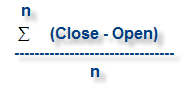Qstick Definition and Formula
The Qstick indicator was developed by Tushar Chande, in order to determine the strength or weakness of a security over ‘x” period of time. The Qstick indicator represents the moving average of the difference between the opening and closing prices of a security. A positive value means the security has had more net points up over “x” period, while a negative value means the security has had more net points down over “x” period. So, if a stock is up 10 points in one day, but down a total of 7 points the other 9 days, the stock will have a positive qstick value. The formula for the rate of Qstick is as follows:

Trading Rules – Qstick
The Qstick like many other technical indicators provides a number of trading signals based on the values of the readings and divergences. Below are three basic rules for trading with the Qstick.
Crossovers
The Qstick oscillates above and below the 0 line. A very basic trading principle is to buy a security on a cross up over the 0 line and to sell the security on a cross down through the 0 line. This technique will work well in sideways markets as the security is more likely to adhere to support and resistance levels.
Extreme Levels
The Qstick also provides extreme readings that can often call market tops and bottoms. The Qstick value has no upper or lower limits, so traders will have to look at previous tops and bottoms in the indicator when going counter to impulsive moves.
Divergence
The last trading rule for the Qstick indicator is to look for divergences between the price of the security and the indicator. So, traders will want to purchase the security if the Qstick value is increasing and the price is moving down. Conversely, traders will want to sell when the Qstick value is falling and the price is rising.


Hi there. I don’t agree with your interpretation of “A positive value means the security has had more up days over “x” period”. If n=10 periods and only 3 have been positive and 7 negative but the positives are +20 point and the 7 are -1 point then it is a positive result even though there are more negatives. In my world it tells if the +bars are more powerful than the -bars. And it is a damn good indicatoer. not doubt about that.
great feedback. I have revised the article